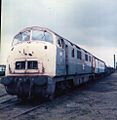British Rail Class 42 facts for kids
Quick facts for kids British Rail Class 42 “Warship” |
|
 |
|
| British Rail Class 42 No. D832 | |
| Power type | Diesel-hydraulic |
|---|---|
| Builder | British Railways’ Swindon Works |
| Build date | 1958–1961 |
| Total production | 38 |
| Configuration | B-B |
| UIC classification | B'B' |
| Gauge | 4 ft 8 1⁄2 in (1,435 mm) |
| Wheel diameter | 3 ft 3+1⁄2 in (1.003 m) |
| Minimum curve | 4.5 chains (91 m) |
| Wheelbase | 48 ft 3 in (14.71 m) |
| Length | 60 ft 0 in (18.29 m) |
| Width | 8 ft 10 in (2.69 m) |
| Height | 12 ft 0+1⁄2 in (3.670 m) |
| Locomotive weight | 78 long tons (79.3 t) |
| Fuel capacity | 800 imp gal (3,600 L; 960 US gal) |
| Prime mover | Maybach MD650, 2 off |
| Transmission | Hydraulic |
| Multiple working | ◆ White Diamond |
| Top speed | 90 mph (145 km/h) |
| Power output | Engines: 1,000 hp (746 kW) × 2 |
| Tractive effort | Maximum: 48,200 lbf (214 kN) |
| Train heating | Steam generator |
| Train brakes | Vacuum |
| Career | British Railways |
| Number | D800–D832, D866–D870 |
| Axle load class | Route availability 7 (RA 6 from 1969) |
| Retired | 1968–1972 |
The British Rail Class 42 "Warship" locomotives were powerful diesel trains. They were first used in 1958. These special trains were designed to be fast and strong. They got their nickname "Warship" because they were named after Royal Navy ships. They were a new type of train for British railways.
Contents
Meet the "Warship" Locomotives
The "Warship" class was a big step for British Railways (BR). They were part of a plan to replace old steam trains with modern diesel and electric ones. These trains were known for their unique look and powerful engines.
A New Kind of Train
The Class 42 "Warships" were diesel-hydraulic trains. This means they used diesel engines to power a special hydraulic system. This system then turned the wheels. It was different from other diesel trains that used electric motors.
British engineers looked to Germany for ideas. They worked with German manufacturers to adapt a successful German design. This design, called the "V200", was made smaller to fit British tracks. The Class 42 trains looked similar to their German cousins. They also used similar engineering ideas.
Built for Speed and Power
These locomotives were designed for speed. They could reach speeds of up to 90 miles per hour (145 km/h). This made them very fast for their time. Each "Warship" had two powerful Maybach diesel engines. Each engine produced 1,000 horsepower. This gave the train a total of 2,000 horsepower.
The Class 42 trains were also strong. They could pull heavy passenger and freight trains. Their design helped them accelerate quickly. This was useful for keeping to tight schedules.
The Two "Warship" Types
The "Warship" locomotives were built in two main groups. The Class 42 trains were built by British Railways. This happened at their Swindon Works. These trains were numbered from D800 to D832 and D866 to D870. There were 38 of these locomotives in total.
Another group of "Warships" was built by a company called North British Locomotive Company. These were numbered D833 to D865. They became known as the British Rail Class 43. Both classes were very similar.
Where They Ran
The "Warship" locomotives mostly operated in the Western Region of British Railways. This area included routes from London to the West Country. They were based at several important train depots. These included Bristol Bath Road, Plymouth Laira, Newton Abbot, and Old Oak Common. They were a common sight on these lines.
End of an Era
The "Warship" locomotives had a relatively short working life. They were introduced in 1958. However, by the late 1960s, British Railways decided to focus on diesel-electric trains. These were seen as more reliable and easier to maintain.
Because of this decision, the Class 42 "Warships" were retired early. Most were withdrawn from service between 1968 and 1972. Sadly, almost all of them were scrapped. Only a few have been saved and preserved. These can sometimes be seen on heritage railways today. They remind us of a unique time in British railway history.
Images for kids
-
D829 'Magpie' waits at Paddington in 1961
-
D821, temporarily renamed Chris Broadhurst, at Kidderminster, Severn Valley Railway, April 2010







